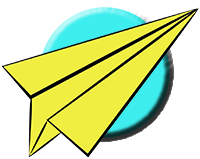Make a Marlin Dart Paper Airplane
Make a Marlin Dart Paper Airplane
Instructions
1. Start with a letter size sheet. Fold the paper exactly in half along its edge. Unfold after the crease has been made.
2. Fold the upper corner down so the upper left point hits the center line crease. When folded correctly, the left half of the top edge should line up with the center crease.
3. Fold the upper right corner down so the upper right point point hits the center line crease. When folded correctly, the right edge should line up with the center line crease.
4. Make a crease to fold the upper left point over so it hits the center line crease. When folded correctly, the upper left diagonal edge should line up with the center line crease.
5. Make a crease to fold the point at the tip of the nose down. The crease should be about two fingers widths below the point formed by the two flaps on the center line crease. The center line creases above and below the new horizontal crease should line up.
6. Make a crease to fold the nose flap back over on top of itself. The crease should be about two finger widths down from the edge at the top of the paper. The center line creases should line up.
7. Rotate the paper around so the nose is pointed down and to the right.
8. Make a crease along the nose so the outside edge of the paper, when folded, lines up with the center crease. Two additional creases must be made to form a hinge in order to fold the flap over.
HINT: Start by folding the flap over at the nose end and then work back.
9. Flip the paper over and rotate it around so the flaps just folded are underneath and the nose is pointed up and to the left.
10. Fold the paper in half about the existing center line crease. Be sure to line up the wing flap for good balance.
11. Rotate the paper around so the nose is pointing to the right and the wing flaps are pointing up.
12. Make a crease for the first wing flap. The crease should follow along the line of the nose and extend upward to the back of the plane about three finger widths from the bottom edge of the fuselage.
13. Flip the paper over so the first wing flap is underneath.
14. Make a crease for the second wing flap. Be sure to line up the wing flaps for balance.
15. Open up the wing flaps and adjust the wing angles so they are even. Open up the forward winglets and adjust the angles; these may be adjusted separately from the main wing flaps. The dihedral angle should be set slightly up.
THE THROW Adjust the elevators for slight lift especially if you add a paper clip to the nose. Launch with a medium to hard throw at a slight up angle. With a lot of up elevator this plane can be launched almost straight up and will flip and float down.
